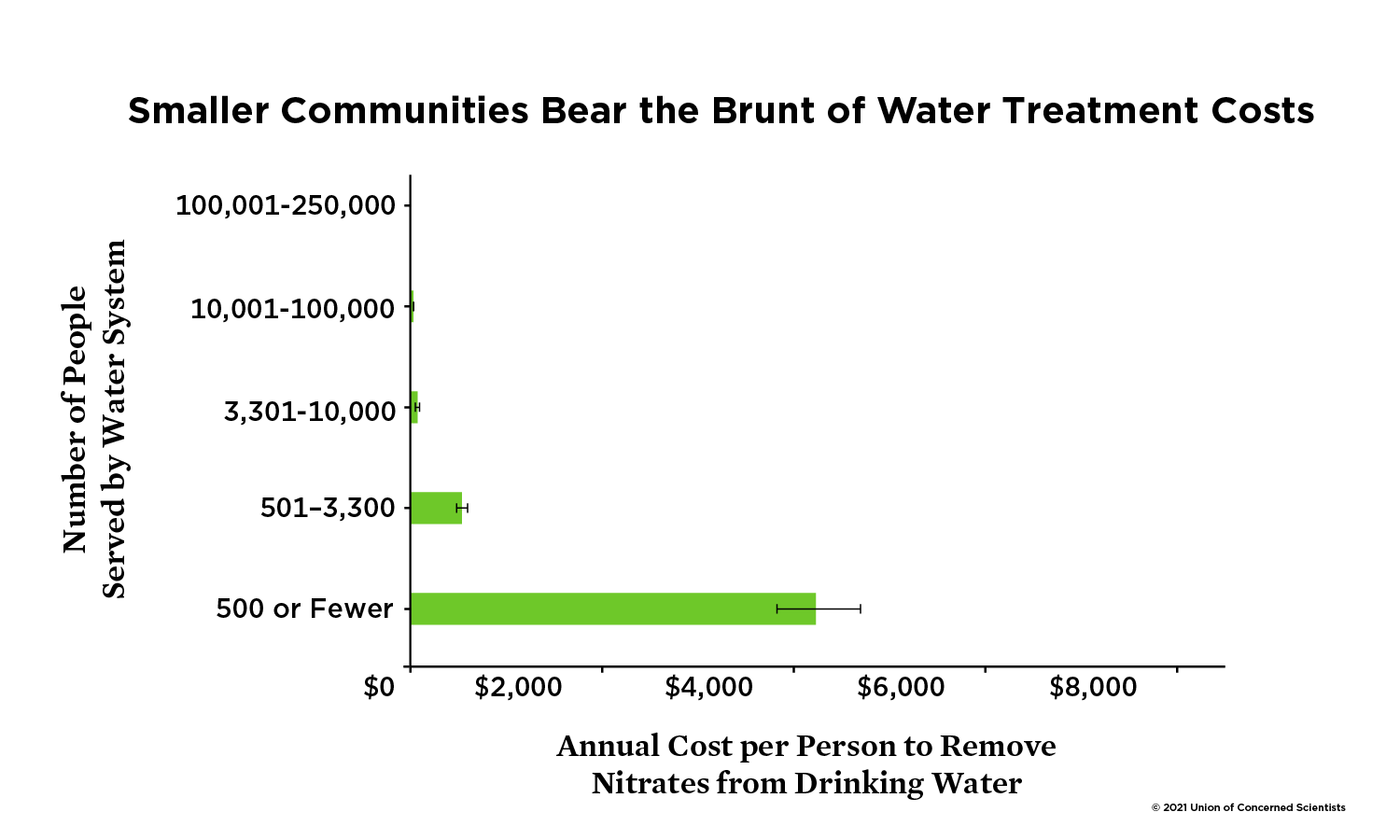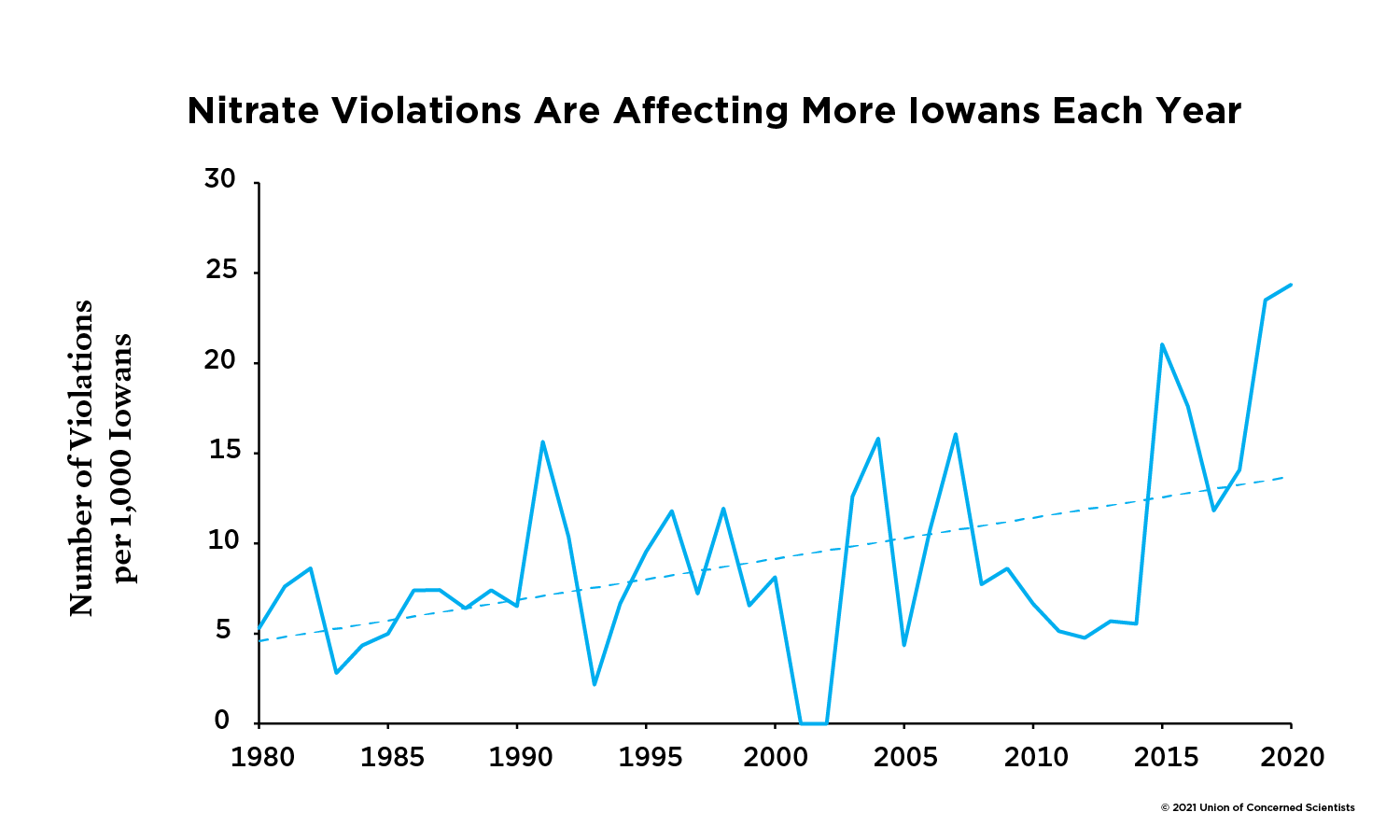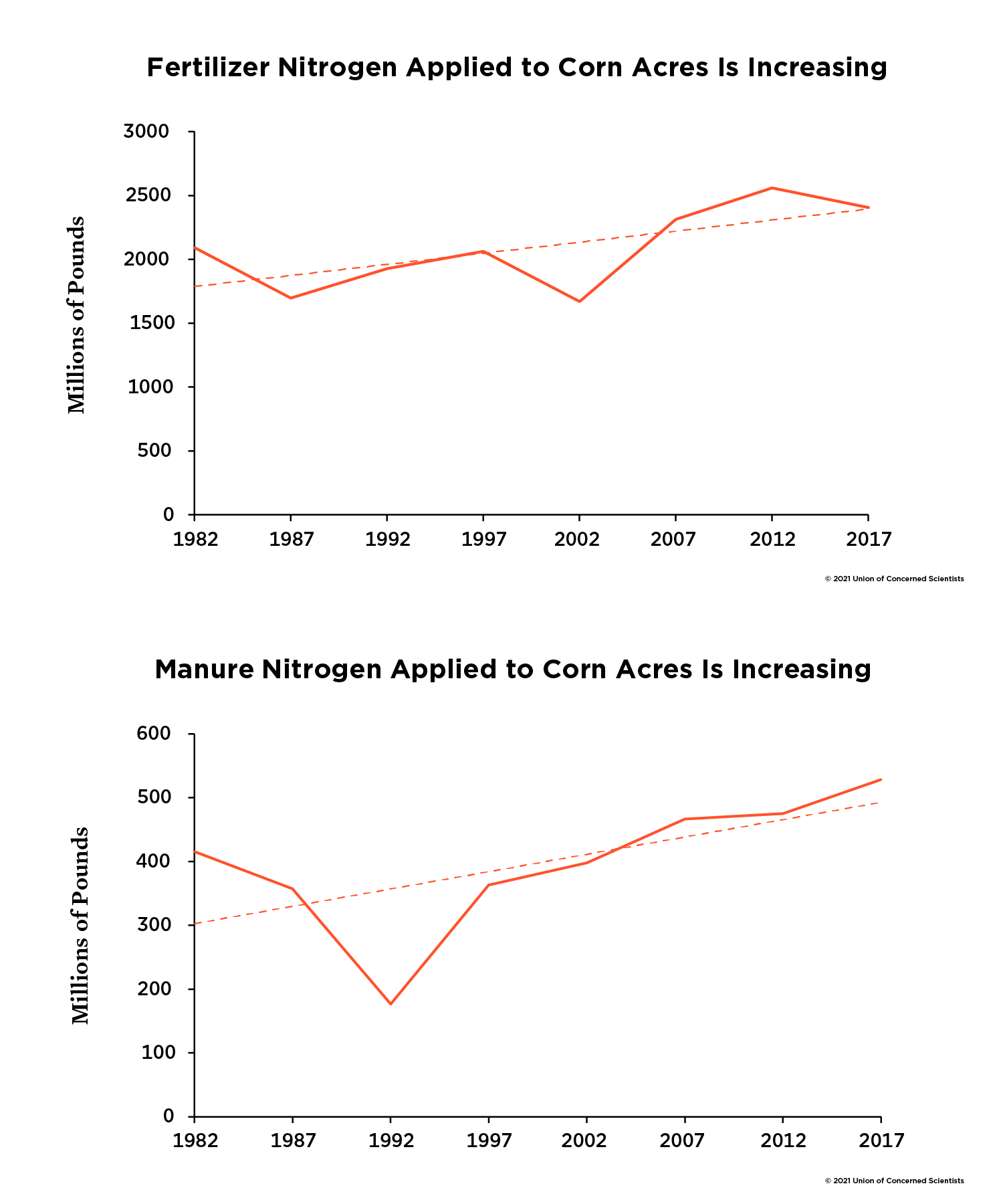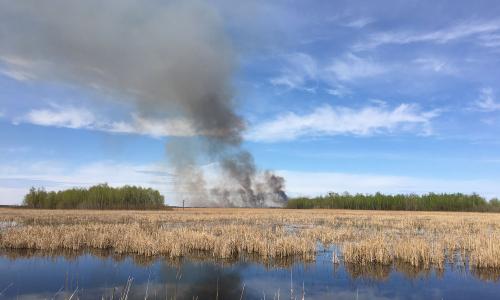The use of synthetic nitrogen and manure fertilizer on Iowa’s 22.7 million acres of corn and soybeans has increased dramatically over the last four decades. So too has the amount of nitrogen that runs off farm fields into waterways, including the state's groundwater sources.
If current trends continue, Iowa will spend between $41 and $333 million over the next five years for continued nitrate removal from drinking water. Nearly three-quarters of this expense is borne by small rural communities.
Preventing this pollution at its source is possible and starts with reducing overapplication of nitrogen fertilizer and improving management of animal manure. Farmers can also adopt science-based farm practices—such as planting cover crops or perennial buffer strips, reducing tillage, incorporating diverse grains into the traditional crop rotations, and integrating livestock and crop production—that build up soil health while reducing the amount of nitrogen that runs off their land.
State and federal policies, including those promoting research, technical assistance, and incentives, are needed to help Iowa’s farmers adopt such practices on a large scale.
Dirty Water, Degraded Soil
Overview
The use of synthetic nitrogen and manure fertilizer on Iowa’s 22.7 million acres of corn and soybeans has increased dramatically over the last four decades. So too has the amount of nitrogen that runs off farm fields into waterways, including the state's groundwater sources. If current trends continue, Iowa will spend between $41 and $333 million over the next five years for continued nitrate removal from drinking water. Nearly three-quarters of this expense is borne by small rural communities. Preventing this pollution at its source is possible and starts with reducing overapplication of nitrogen fertilizer and improving management of animal manure. Farmers can also adopt science-based farm practices—such as planting cover crops or perennial buffer strips, reducing tillage, incorporating diverse grains into the traditional crop rotations, and integrating livestock and crop production—that build up soil health while reducing the amount of nitrogen that runs off their land. State and federal policies, including those promoting research, technical assistance, and incentives, are needed to help Iowa’s farmers adopt such practices on a large scale.
Analysis: Treating drinking water for nitrates costs Iowa millions of dollars every year
Iowa’s corn and row crop–dominated agriculture uses large quantities of nitrogen fertilizer, while its livestock confined animal feeding operations (CAFOs) produce large quantities of manure containing nitrogenous compounds, so nitrates are common in drinking water sources across the state. Therefore, public water systems across Iowa have been treating their drinking water for nitrates for decades. These harmful contaminants run off farm fields and livestock facilities into waterways and groundwater that are drinking water sources. Nitrates in drinking water are harmful to public health—especially for pregnant women and infants—so it is essential that they be removed through treatment systems.
Mismanagement of nitrogen on crop and livestock farms has a heavy public cost. One such cost is the removal of nitrates in drinking water. We estimate that this can be as high as $4,960 annually per capita (in 2020 dollars, and all such dollar values hereafter), although these costs diminish drastically when they are distributed over a larger tax base. This means that costs are borne disproportionately by small rural communities embedded in farmland, which describes most of Iowa.
Our analysis of Environmental Protection Agency (EPA) Safe Drinking Water Information System (SDWIS) data found that in 2020, 58 of Iowa’s public water systems treated 82 billion gallons of drinking water for nitrates using either reverse osmosis or ion exchange technology. We estimate that it will cost Iowans between $41 and $333 million over the next five years to continue to operate and maintain facilities that remove nitrate from drinking water. We also find that the vast majority of this cost will be borne by small rural communities, due in part to their proximity to agricultural sources of nitrate pollution and because small water systems can be relatively more expensive to operate and maintain than large ones on a per-gallon basis (Figure 1).
Our cost estimates for the next five years are conservative. First, they do not take into account the construction, operation, or maintenance of new treatment plants. New treatment plants will undoubtedly come on line in the coming years, as more and more public water systems in Iowa experience higher levels of nitrate contamination. Further, over 200,000 Iowans rely on private wells for their drinking water, and recent evidence indicates that up to 25 percent of these are contaminated with unsafe levels of nitrates. Private well owners are not mandated to test for nitrates. If they discover nitrates and treat their water, they do so at their own expense, so we do not include their costs in our estimates.

Data on treatment costs derived and adapted from Iowa State’s Economic Benefits of Nitrogen Reductions in Iowa report.
In drinking water, nitrogen Is a harmful pollutant
High nitrate levels in drinking water can cause acute and deadly health problems such as neural tube defects in utero and blue baby syndrome in infants. Some studies have found that chronic exposure to nitrates at lower levels (well below the EPA’s legal threshold) is associated with increased risk for some cancers. In Iowa, recent research has estimated that up to 300 cases of cancer each year are caused by exposure to nitrates in drinking water. The same study also reported that on average medical costs to treat these cancers can be as high as $212,000 per person. If all 300 of the annual cancer cases caused by nitrates in Iowa were treated at this level, the state would be spending $63.7 million on their medical care alone.
We analyzed data collected from the SDWIS to understand the extent of nitrate violations in Iowa’s public water systems. The EPA issues violations to public water systems when water samples exceed the agency's maximum contaminate level (MCL) for nitrate. Consequently, the responsibility to treat the water falls on the public water system. Based on our analysis of these violation data, from 1980 to 2020, Iowa public water systems violated the EPA's MCL 1,100 times. This is likely an underestimate of the frequency of nitrate MCL violations because roughly one-fifth of public water systems failed to meet federal requirements for nitrate monitoring. Even so, our analysis indicates that the number of violations per 1,000 Iowa residents affected has increased steadily over the last four decades (Figure 2).
Our analysis also finds that rural Iowans, who make up only 36 percent of the state’s population, bear the disproportionate burden of nitrate contaminated drinking water. Since 1980, nearly 97 percent of nitrate MCL violations have occurred in water systems serving fewer than 3,300 residents.

Contaminated drinking water is only one problem caused by mismanagement of nitrogen fertilizer on Iowa farms
Nitrogen-polluted water also harms aquatic life via eutrophication—which may cause a depletion of oxygen in aquatic ecosystems—in the streams, rivers, ponds, and lakes all across Iowa. Closer to home, economists have estimated that nitrate contamination of these water bodies costs the state tens of millions of dollars annually in recreational benefits. Further, when nitrogen pollution leaves Iowa farms and livestock operations it enters large riverways where it causes harm at a distance. The largest example is the Mississippi River, draining into the Gulf of Mexico and creating the Gulf dead zone, a low-oxygen area the size of Connecticut and Delaware combined that harms shrimp and other commercially important fisheries. This is one of the largest of over 500 documented dead zones that have been documented around the globe since 1950.
The rise of synthetic nitrogen fertilizer and manure use by Iowa corn farmers
Corn production dominates the Midwest and Iowa landscape and is used in large part to feed millions of cattle, hogs, and chickens raised in the region. The production of ethanol, a biofuel made from corn to be blended with gasoline, is also concentrated in the Midwest. For many decades, farmers relied on animals and natural sources of nitrogen to fertilize crops. Livestock production was integrated with crop production. In such systems, farmers used livestock manure (containing plentiful quantities of nitrogen) to support crop growth and yields. However, technological advances in how synthetic nitrogen fertilizer is made combined with industrial specialization of crop and livestock production have led US farmers to rely heavily on synthetic nitrogen fertilizer to boost crop growth and yields.
Using county-level crop production data from the US Department of Agriculture’s (USDA) Census of Agriculture (1982 to 2017), combined with farm nitrogen application data for the same period from the US Geological Survey, we estimate that in Iowa the average level of fertilizer nitrogen applied per corn acre has been increasing slowly since the 1980s, from 167 pounds (lb) per acre to 193 lb in 2017. So too has the total amount of nitrogen applied across all Iowa counties (Figure 3). In total, 2.4 billion lb of fertilizer nitrogen were applied to corn crops grown in the state in 2017, compared to just 2.1 billion in 1982.
One half of all nitrogen applied to crops is lost to air, soil, and water. On average, one-third of the nitrogen applied as fertilizer to crops can leach into groundwater or run off farm fields into streams and rivers. We estimate that 800 million lb of nitrogen applied as fertilizer in Iowa in 2017 ended up in waterways, including those supplying drinking water. To make matters worse, installation of additional drainage systems on Iowa cropland is significantly increasing nitrogen losses to waterways.
In addition to using synthetic nitrogen fertilizer, farmers apply manure on their farmland. This manure, containing plentiful amounts of nitrogen in aggregate, is produced by animal feeding operations or large CAFOs that raise dairy and beef cattle, chickens, turkeys, and hogs.
Using USDA Census of Agriculture data on the number of animals produced per county (1982 to 2017) and data on the amount of manure produced per livestock animal, we found that in 2017 alone, 116 billion lb of manure were generated by 88.6 million dairy and beef cattle, chickens, turkeys, and hogs in Iowa. This manure contained an estimated 991 million lb of elemental nitrogen (see Figure 3 for our estimate of the share of elemental nitrogen in manure applied to corn acres). Total manure produced has increased over the last four decades from 107 billion lb in 1982, or an 8 percent increase. In total, we estimate that 3.8 trillion lb of manure have been produced by livestock in Iowa between 1982 and 2017.

Appropriately disposing of manure is costly, which is why dumping it on farmland has become a common practice. Manure is commonly gifted or bartered between livestock producers and crop producers in Iowa. In many cases it is applied when land is bare in the fallow season or to rotations of soybeans. These practices have further exacerbated the nitrogen pollution problems in waterways.
Solutions
We need a shift to agroecological systems and healthy-soil practices
Agroecological systems have already taken root in Iowa and other states through adoption of cover crops, diversified crop rotations, perennial buffer strips, reduced tillage, and many other healthy-soil practices. Adopting these practices has been shown to reduce nitrogen losses from farms, which in aggregate can reduce the cost of treating drinking water sources for nitrates. Reduced water treatment will be especially important to many of the small rural communities in Iowa that face a disproportionate burden for the cost of nitrate removal.
And there is a bonus. Equally important are the benefits these practices offer Iowa and Midwest farmers as they face increased floods and droughts due to climate change. The large quantity of heat trapping emissions already in our atmosphere locks us into substantial climate warming over the next century. We have already had a preview of the damage climate change can do to farms. In 2019, a series of record-shattering rainstorms began in March, battering several Midwestern states for months. Overflowing rivers, broken levees, and flooding wrought havoc all over the region. Economists estimated these storms caused $2 billion in damages in Iowa, mostly to agriculture. And then in 2020, a fast-moving series of wind- and thunderstorms—deemed later a derecho—damaged over 14 million acres of farmland costing $3.8 million to repair in Iowa. Adoption of agroecological systems and healthy-soil practices have been proven through rigorous scientific studies to help farmers adapt to climate change and reduce the heat trapping emissions they generate, all while preserving soil and protecting our waterways and water supply.
However, crops are just one component of a truly agroecological system. As our analysis demonstrates, CAFOs are a major contributor of polluting nitrates to Iowa's waterways. One way to tackle the pollution problem is through reintegration of livestock with crop production. This type of farming system has been shown to have substantial environmental benefits, including reduced nitrogen losses from farm fields.
While encouraging from an environmental and climate standpoint, the economic effects of widespread adoption of integrated crop and livestock systems underscore additional considerations and require further study. A 2017 study in Iowa demonstrates that these integrated systems can be profitable, but they do have higher labor and capital costs compared to traditional cropping systems in Iowa. Another 2017 study by the Union of Concerned Scientists (UCS) found that economic returns per acre for integrated crop and beef grazing farms were substantially higher than the conventional, separated animal and crop production systems. Economic analyses accounting for dynamic supply and demand shifts and feedbacks are needed to better understand the viability of widespread adoption of integrated livestock and cropping systems. To solve Iowa's water quality problem and give farmers a fighting chance against a changing climate, policymakers must support farmers to overcome obstacles and help drive the shift towards agroecological farming and integrated livestock systems.
Iowa legislators should therefore undertake the following:
- Create a science-based soil health index. The index will be used to assess and measure Iowa’s soil health, in terms of either outcomes (e.g., quantitative measurements of soil health such as water-holding capacity or infiltration or organic matter content) or practices (e.g., use of cover crops, diverse crop rotations, etc.) using a whole farm approach. An annual report on the health of Iowa's soils will be published based upon the soil health index.
- Appropriate state funding for education and outreach about soil health, manure management, and water pollution in Iowa. Fund programs to educate farmers, landowners, lenders, and farm managers about healthy soil practices, how to measure soil health, and how to use manure as a fertilizer for crops. This fund could also help create sample lease agreements that include provisions that require land operators to use evidence-based healthy-soil practices on leased land.
- Develop a new state task force. Reporting to state legislators, the task force would develop and advocate for policy recommendations that address water quality issues caused by crop and livestock production.
- Reimagine the state's livestock industry and its regulatory framework. In February 2020, researchers from Drake University, Iowa State University, and the University of Iowa penned an op-ed in the Des Moines Register calling for changes to CAFO-siting governance, regulation of crop production on land in flood plains and near waterways, and regulation of application of synthetic nitrogen fertilizer and manure on farm fields. If nitrate pollution is to be truly reduced in the state's waterways, shifts in practices on agricultural land must be complemented by shifts in livestock production.
Federal policymakers can help support Iowa farmers and solve the state’s water pollution challenges through the following actions:
- Reintroduce the Agriculture Resilience Act.** This bill can help Iowa farmers shift to ecologically informed practices that reduce nitrogen losses and provide protection against extreme weather events caused by climate change.
- Ensure that farmers have economically viable options to retire farmland. Retiring land and preserving it through conservation easements is one way to reduce total synthetic nitrogen fertilizer use in Iowa and would complement strategies to reduce nitrogen application per acre of working farmed land. Federal easement programs such as the Conservation Reserve Program should continue to be funded, and the amount farmers receive for these easements should be increased if new incentives for added crop production—such as the Renewable Fuel Standard program or carbon markets—are introduced and enacted at the federal level.
- Improve federal enforcement of regulation of water pollution from CAFOs in Iowa. CAFOs are regulated under the Clean Water Act and must apply for permits to manage and dispose of manure in waterways. However, these regulations are not strictly enforced. The EPA must do more to regulate the pollution originating from CAFOs. Otherwise, water quality in Iowa will not improve, even if healthy soil practices are widely adopted on the state’s farmland.
- Increase public investments in interdisciplinary research on integrated crop and livestock systems through the USDA and the National Science Foundation. Research that evaluates how farmers can overcome obstacles to shifting to such systems is needed. Further, research on how widespread adoption of integrated crop and livestock systems affects supply, demand, and price changes for corn, soybeans, and livestock would help us understand broad economic implications of shifts to these alternative systems for farmers and consumers.
Policy can help solve the water pollution problem in Iowa. If we support farmers in the adoption of agroecological practices and alternative production systems, their actions will reduce water treatment costs for the state of Iowa and its rural communities. At the same time, these farmers will also be better equipped to face the challenges presented by climate change. This is an example of multiple wins from forward-focused policy, for farmers, users of municipal water systems, taxpayers, the environment, wild and farmed animal life, and the climate.
References
Agriculture Resilience Act of 2020, H.R. 5861, 116th Cong. (2019–2020). https://www.congress.gov/bill/116th-congress/house-bill/5861
Boehm, Rebecca. 2020. Reviving the Dead Zone. Washington, DC: Union of Concerned Scientists. https://www.ucsusa.org/resources/reviving-dead-zone
Breitburg, Denise, Lisa A. Levin, Andreas Oschlies, Marilaure Grégoire, Francisco P. Chavez, Daniel J. Conley, Véronique Garçon, et al. 2018. "Declining Oxygen in the Global Ocean and Coastal Waters." Science 359 (46): 6371–82. https://10.1126/science.aam7240
Cao, Peiyu, Chaoqun Lu, and Zhen Yu. 2018. “Historical Nitrogen Fertilizer Use in Agricultural Ecosystems of the Contiguous United States during 1850–2015: Application Rate, Timing, and Fertilizer Types.” Earth System Science Data 10 (2): 969–84. https://doi.org/10.5194/essd-10-969-2018
DeLonge, Marcia. 2015. “The ABCD’s of Agroecology: What Is It All About?” Union of Concerned Scientists (blog). October 15, 2015. https://blog.ucsusa.org/marcia-delonge/the-abcds-of-agroecology-what-is-it-all-about-926
DeLonge, Marcia. 2017. Reintegrating Land and Livestock: Agroecological Solutions to Beef Systems Challenges. Cambridge, MA: Union of Concerned Scientists. https://www.ucsusa.org/sites/default/files/attach/2017/11/reintegrating-land-and-livestock-ucs-2017.pdf
Eller, Donnelle. 2019. “Farm Losses Drive Iowa’s Flood Damage to $2 Billion, Farm Bureau Economists Estimate.” Des Moines Register, April 3, 2019. https://www.desmoinesregister.com/story/money/agriculture/2019/04/03/iowa-flooding-nebraska-missouri-river-farm-losses-damage-2-billion-ag-group-bureau-crop-insurance/3351972002/
Eller, Donnelle. 2020. “Iowa’s Impaired Rivers, Lakes, Streams Decline Slightly, DNR Says.” Des Moines Register, December 1, 2020. https://www.desmoinesregister.com/story/money/agriculture/2020/12/01/iowa-dnr-impaired-water-quality-pollution-report-2020/6476709002/
Environmental Services Division, Water Quality Bureau, Water Supply Engineering and Operations Section. 2020. State of Iowa Public Drinking Water Program 2019 Annual Compliance Report. Des Moines: Iowa Department of Natural Resources. http://publications.iowa.gov/32843/1/SAR2019.pdf
EWG. 2017. “EWG Investigation: Across Farm Country, Nitrate Pollution of Drinking Water for More Than 20 Million Americans Is Getting Worse.” Washington, DC. http://www.ewg.org/interactive-maps/2020-nitrate-pollution-of-drinking-water-for-more-than-20-million-americans-is-getting-worse/ia/
Food & Water Watch, et al. n.d. “Petition to Revise the Clean Water Act Regulations for Concentrated Animal Feeding Operations.” Accessed December 17, 2020. https://www.mitchellwilliamslaw.com/concentrated-animal-feeding-operations-food-water-watch-et-al-petition-requesting-clean-water-act-regulation-revisions
Garrett, Rachael D., Meredith Niles, Juliana Gil, Philip Dy, Julio Reis, and Judson Valentim. 2017. “Policies for Reintegrating Crop and Livestock Systems: A Comparative Analysis.” Sustainability 9 (3): 473. https://doi.org/10.3390/su9030473
Good, Keith. 2020. "Derecho Damage Begins to Unfold: Estimated 37.7 Million Acres of Farmland Impacted." Farm Policy News, August 16, 2020. https://farmpolicynews.illinois.edu/2020/08/derecho-damage-begins-to-unfold-estimated-37-7-million-acres-of-farmland-impacted/#:~:text=%E2%80%9CThe%20USDA%20said%20the%20storm,acres%20may%20have%20been%20impacted.%E2%80%9D
Gronberg, Jo Ann M., and Norman E. Spahr. 2012. County-Level Estimates of Nitrogen and Phosphorus from Commercial Fertilizer for the Conterminous United States, 1987–2006. Scientific Investigations Report 2012–5207. Reston, VA: US Geological Survey. https://doi.org/10.3133/sir20125207
Growing Climate Solutions Act of 2020, H.R. 7393, 116th Cong. (2019–2020). https://www.congress.gov/bill/116th-congress/house-bill/7393/all-info
Hamilton, Neil, Matt Liebman, Silvia Secchi, and Chris Jones. 2020. “Iowa’s Water Quality Strategy Is Not Working. Here’s What Should Be Done Instead.” Des Moines Register, February 7, 2020. https://www.desmoinesregister.com/story/opinion/columnists/iowa-view/2020/02/07/iowa-water-quality-new-strategy-needed/4546560002/
Howard, Jenny. 2019. "Dead Zones, Explained." National Geographic. August 1. https://www.nationalgeographic.com/environment/oceans/dead-zones/.
Imerman, Mark, Edward Osenbaugh, and Eric Imerman. 2020. Talkin’ Shit: Capturing the Value of Iowa Livestock Manure. Des Moines, IA: Regional Strategic. https://regionalstrategic.com/?creativo_portfolio=talkin-shit-capturing-the-value-of-iowa-livestock-manure
Iowa Community Indicators Program. 2020. “Urban Percentage of the Population for States, Historical.” Ames: Iowa State University. https://www.icip.iastate.edu/tables/population/urban-pct-states
Jones, Chris. 2019. “By the Numbers.” Chris Jones, IIHR Research Engineer (blog). February 28. https://www.iihr.uiowa.edu/cjones/by-the-numbers/
Lorimor, Jeff, Wendy Powers, and Al Sutton. 2004. Manure Characteristics. MWPS-18 Section 1: Manure Management Systems Series. Ames: Midwest Planning Center, Iowa State University. https://www-mwps.sws.iastate.edu/catalog/manure-management/manure-characteristics
Majumdar, Deepanjan. 2003. “The Blue Baby Syndrome.” Resonance 8 (10): 20–30. https://doi.org/10.1007/BF02840703
Natural Resources Conservation Service. 2012. Assessment of the Effects of Conservation Practices on Cultivated Cropland in the Upper Mississippi River Basin. Washington, DC: US Department of Agriculture. https://www.nrcs.usda.gov/Internet/FSE_DOCUMENTS/stelprdb1042093.pdf
Office of Representative Chellie Pingree. 2020. “The Agriculture Resilience Act.” Press release, February. https://pingree.house.gov/netzeroagriculture/agriculture-resilience-act.htm
Poffenbarger, Hanna, Georgeanne Artz, Garland Dahlke, William Edwards, Mark Hanna, James Russell, Harris Sellers, and Matt Liebman. 2017. “An Economic Analysis of Integrated Crop-Livestock Systems in Iowa, U.S.A.” Agricultural Systems 157 (October): 51–69. https://doi.org/10.1016/j.agsy.2017.07.001
Porter, Sarah A., and David E. James. 2020. “Using a Spatially Explicit Approach to Assess the Contribution of Livestock Manure to Minnesota’s Agricultural Nitrogen Budget.” Agronomy 10 (4): 480. https://doi.org/10.3390/agronomy10040480
“Practical Farmers of Iowa.” 2020. Research Reports. 2020. https://practicalfarmers.org/resources/
Stillerman, Karen Perry, and Marcia DeLonge. 2019. Safeguarding Soil. Washington, DC: Union of Concerned Scientists. https://www.ucsusa.org/resources/safeguarding-soil
Tang, Chuan, Gabriel E. Lade, David Keiser, Catherine Kling, Yongjie Ji, and Yau-Huo Shr. 2018. Economic Benefits of Nitrogen Reductions in Iowa. Ames: Iowa State University. https://www.card.iastate.edu/products/publications/texts/water-quality-report.pdf
Temkin, Alexis, Sydney Evans, Tatiana Manidis, Chris Campbell, and Olga V. Naidenko. "Exposure-Based Assessment and Economic Valuation of Adverse Birth Outcomes and Cancer Risk Due to Nitrate in United States Drinking Water." Environmental Research 176 (2019): 108442. https://doi.org/10.1016/j.envres.2019.04.009
US Department of Agriculture. 2017. 2017 Census of Agriculture. Washington, DC. https://www.nass.usda.gov/Publications/AgCensus/2017/Full_Report/Volume_1,_Chapter_1_US/
US Department of Energy. n.d. “Ethanol Production and Distribution.” Accessed December 17, 2020. https://afdc.energy.gov/fuels/ethanol_production.html
US Environmental Protection Agency. n.d. “Clean Water Act (CWA) Compliance Monitoring.” Accessed December 17, 2020. https://www.epa.gov/compliance/clean-water-act-cwa-compliance-monitoring
US Environmental Protection Agency. n.d. “Climate Impacts in the Midwest.” Accessed December 17, 2020. https://climatechange.chicago.gov/climate-impacts/climate-impacts-midwest
US Environmental Protection Agency. n.d. “Overview for Renewable Fuel Standard.” Accessed December 17, 2020. https://www.epa.gov/renewable-fuel-standard-program/overview-renewable-fuel-standard
US Environmental Protection Agency. n.d. “Safe Drinking Water Information System (SDWIS) Federal Reporting Services.” Accessed December 17, 2020. https://www.epa.gov/ground-water-and-drinking-water/safe-drinking-water-information-system-sdwis-federal-reporting
US Senate Committee on Agriculture, Nutrition, and Forestry. 2020. “Stabenow, Braun Introduce New Bipartisan Bill to Help Family Foresters Develop Climate Solutions, Access Economic Opportunity.” Press release, August 5. https://www.agriculture.senate.gov/newsroom/dem/press/release/stabenow-braun-introduce-new-bipartisan-bill-to-help-family-foresters-develop-climate-solutions-access-economic-opportunity
Ward, Mary H., Rena R. Jones, Jean D. Brender, Theo M. De Kok, Peter J. Weyer, Bernard T. Nolan, Cristina M. Villanueva, and Simone G. Van Breda. 2018. “Drinking Water Nitrate and Human Health: An Updated Review.” International Journal of Environmental Research and Public Health 15 (7): 1557. https://doi.org/10.3390/ijerph15071557
Zhang, Xin, Eric A. Davidson, Denise L. Mauzerall, Timothy D. Searchinger, Patrice Dumas, and Ye Shen. 2015. “Managing Nitrogen for Sustainable Development.” Nature 528 (7580): 51–9. https://doi.org/10.1038/nature15743
Acknowledgments
This report was made possible through the support of the Grantham Foundation for the Protection of the Environment and UCS members.
For their thoughtful reviews and contributions, we thank Anne Schechinger (Environmental Working Group), John Norris (State Public Policy Group), and anonymous reviewers. At UCS, Betty Ahrens, Charlotte Kirk Baer, Marcia DeLonge, Cynthia DeRocco, Sam Eley, Abby Figueroa, Brian Middleton, Kathy Rest, Ricardo Salvador, and Karen Perry Stillerman for their help in developing and refining this report. We also thank Leslie Brunetta for her editing work. Organizational affiliations are listed for identification purposes only. The opinions expressed herein do not necessarily reflect those of the organizations that funded the work or the individuals who reviewed it. The Union of Concerned Scientists bears sole responsibility for the report’s contents.
Citation
Boehm, Rebecca. 2021. Dirty Water, Degraded Soil: The Steep Costs of Farm Pollution, and How Iowans Can Fix It Together. Cambridge, MA: Union of Concerned Scientists. https://www.ucsusa.org/node/13929



